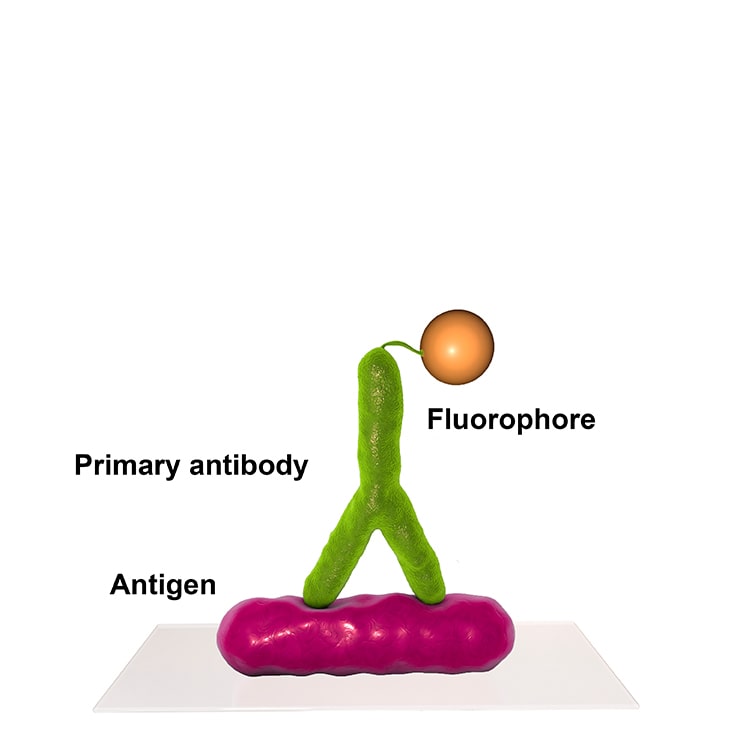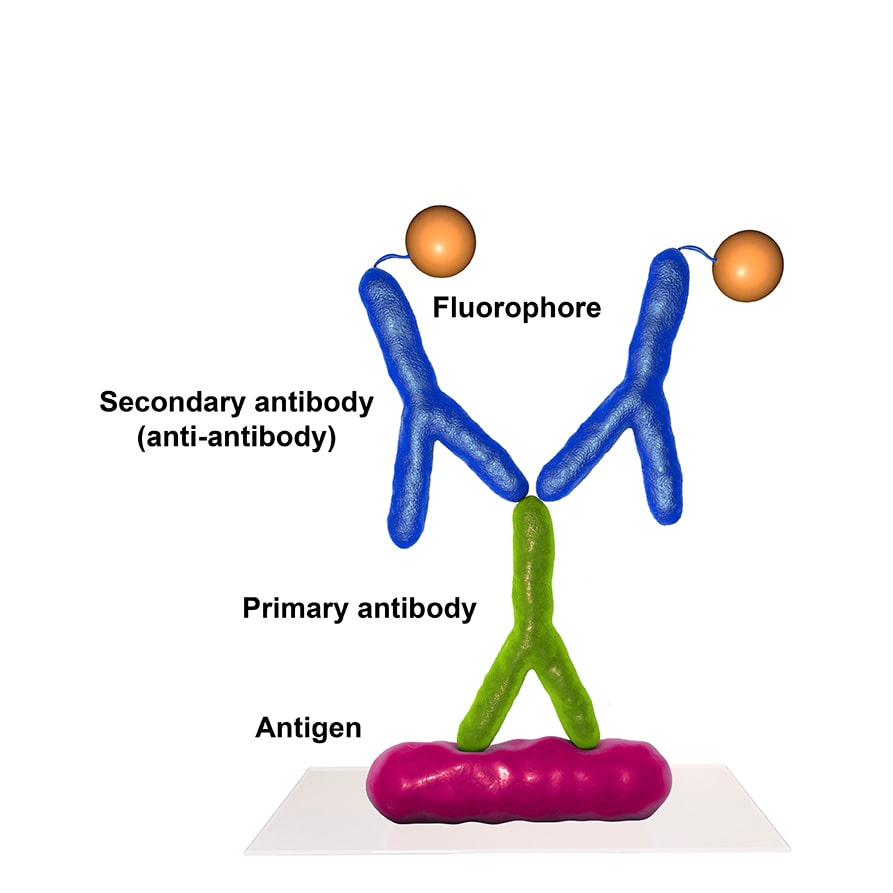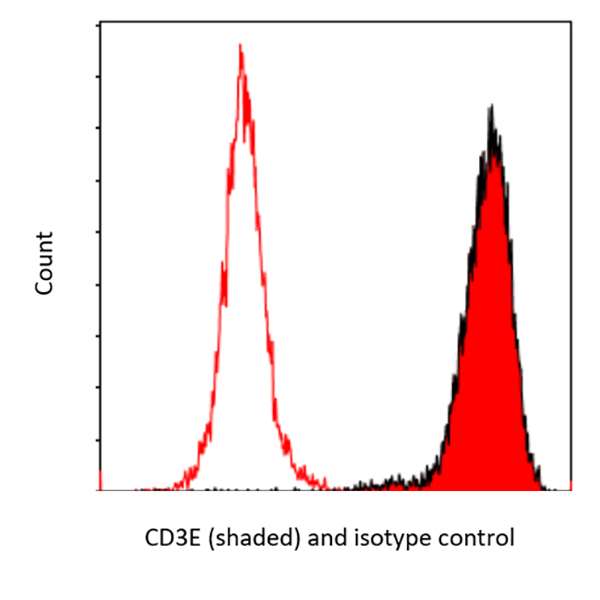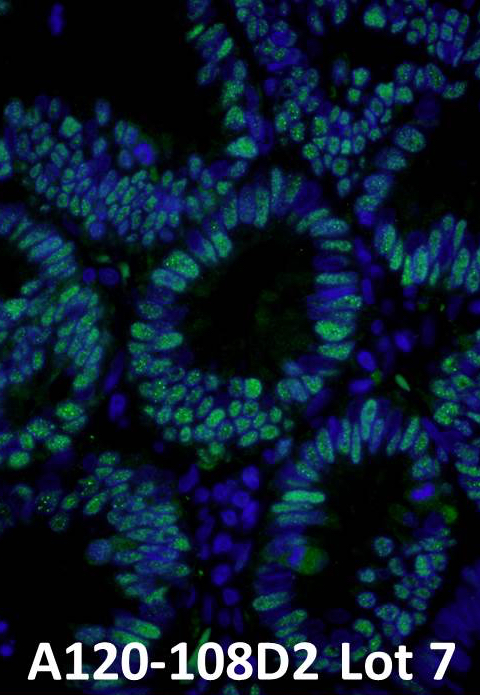Custom Antibody Conjugation Service
At Fortis Life Sciences, we offer a wide range of antibody conjugation solutions to enable you to find the perfect solution for your research purposes. We offer a fixed product range of conjugated antibodies, and also offer a custom antibody conjugation service to meet your specific experimental requirements.
Antibody Conjugation Detection Methods
Direct Detection Method
One-step immunolabeling procedure in which a conjugated primary antibody binds its target antigen or analyte for generating a detection signal in the sample being tested.
Pros: Low background signal, minimal species cross-reactivity, great for multiplexing
Cons: Lower sensitivity, less flexibility from limited availability of conjugated primary antibodies

Indirect Detection Method
Two-step method in which an unconjugated primary antibody binds the target antigen or analyte, and then a labeled secondary antibody detects the bound primary for generating the final signal.
Pros: More flexible, highly sensitive (i.e., the signal is enhanced with secondary antibody)
Cons: Longer procedure, non-specific background of secondary limits multiplexing

Custom Conjugated Antibodies
DyLight® & Other Fluorophores
DyLight® Conjugated Antibodies Applications
Flow Cytometry

Detection of CD3E by flow cytometry using anti-CD3E recombinant mAb (shaded red) [clone BL-298-5D12] [A700-016] and a DyLight® conjugated Goat-anti Rabbit IgG secondary antibody [A120-201D5].
IHC


Detection of CD3E by flow cytometry using anti-CD3E recombinant mAb (shaded red) [clone BL-298-5D12] [A700-016] and a DyLight® conjugated Goat-anti Rabbit IgG secondary antibody [A120-201D5].
Western Blot

A fluorescent Western blot of hnRNP showing the multiplex use of our DyLight® 680 Conjugated Donkey anti-Mouse IgG-Heavy and Light Chain Cross-Adsorbed secondary antibody (red) [A90-337D6], with two other fluorescent labeled antibodies.

The spectral characteristics of DyLight® and other fluorophore options we offer*:
|
Fluorescent Conjugate |
Excitation Wavelength (nm) |
Emission Wavelength (nm) |
Emission Color |
Spectrally Equivalent Dyes |
|
Cy2® |
483-485 |
500 |
Green |
Alexa Fluor® 488, ATTO® 488, CF®488A, DyLight® 488, FITC, Fluorescein |
|
Cy3® |
554 |
566 |
Yellow |
Alexa Fluor® 555, CF®555, DyLight® 550, TRITC |
|
Cy5® |
649 |
666 |
Red |
Alexa Fluor® 647, ATTO® 647N, CF®640R, CF®647, DyLight® 650 |
|
Cy5.5® |
672-673 |
690 |
Red |
Alexa Fluor® 680, CF®680, DyLight® 680, IRDye® 680 |
|
DyLight® 350 |
351 |
434 |
Blue |
Alexa Fluor® 350, AMCA, CF®350 |
|
DyLight® 488 |
492 |
519 |
Green |
Alexa Fluor® 488, ATTO® 488, CF®488A, Cy2®, FITC, Fluorescein |
|
DyLight® 550 |
553 |
569 |
Yellow |
Alexa Fluor® 555, CF®555, Cy3®, TRITC |
|
DyLight® 594 |
591 |
617 |
Orange |
Alexa Fluor® 594, ATTO® 594, CF®594, Texas Red |
|
DyLight® 650 |
651 |
673 |
Red |
Alexa Fluor® 647, ATTO® 647N, CF®640R, CF®647, Cy5® |
|
DyLight® 680 |
676 |
705 |
Red |
Alexa Fluor® 680, CF®680, Cy5.5®, IRDye® 680 |
|
DyLight® 755 |
750 |
771 |
Near Infrared |
Alexa Fluor® 750, CF®750, Cy7®, APC, IRDye® 750 |
|
DyLight® 800 |
770 |
798 |
Infrared |
CF®770, IRDye® 800 |
|
FITC |
495 |
519 |
Green |
Alexa Fluor® 488, ATTO® 488, CF®488A, DyLight® 488, FITC, Fluorescein |
|
PE |
565 |
576 |
Red |
Alexa Fluor® 568, ATTO® 565, CF®568 |
Enzyme Conjugated Antibodies
![IHC-P of human tonsil IHC-P of human tonsil with rabbit anti-CD8 alpha recombinant mAb [clone BLR044F], A700-044 and HRP conjugated anti-rabbit secondary antibody followed by DAB-based detection](https://cdn-tp1.mozu.com/31165-51694/cms/files/e67ea44e-4522-43ec-8dec-3420fbea87ef)
IHC-P of human tonsil with rabbit anti-CD8 alpha recombinant mAb [clone BLR044F] [A700-044] and HRP conjugated anti-rabbit secondary antibody followed by DAB-based detection.
Signal Amplifying Conjugates
Request information for Custom Conjugation Service
By clicking “Acknowledge”, you consent to our website's use of cookies to give you the most relevant experience by remembering your preferences and to analyze our website traffic.

